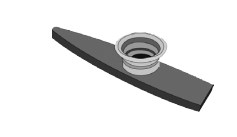In this activity, students create their own homemade kazoos to illustrate that sound vibrations can be seen, heard, felt, and amplified.

When you hum into the kazoo, vibrations from your vocal cords travel through the tube, vibrating the air molecules. The waxed-paper membrane that on the other end of the tube creates additional vibration, amplifying the sound.
The sound you make with your voice has a main pitch. But the distinctive sound of your voice is a result of harmonics, quieter vibrations at higher pitches. The harmonics are also amplified by the kazoo but not all of them are amplified by the same amount. That's why the kazoo makes your humming sound so weird.
When the kazoo's air hole is open, air can travel freely, and the kazoo sounds louder than when your finger covers the hole.
A typical kazoo given out at children's parties is a tapered plastic tube with a cap on it. The vibrating waxed paper or plastic is located in the cap. Simply blowing into the kazoo will not cause the wax paper to vibrate – it needs sound waves in order to vibrate.



